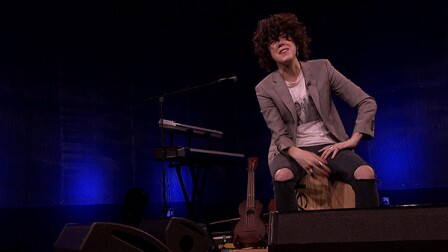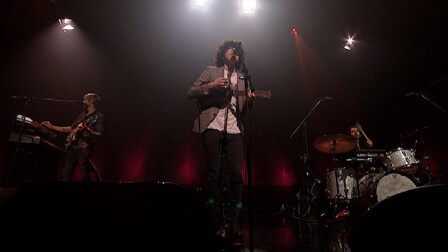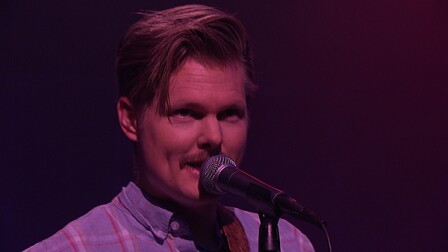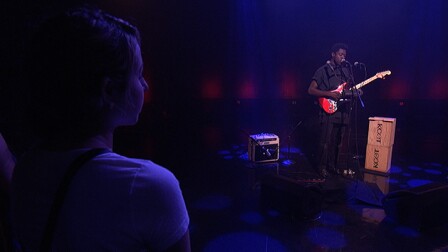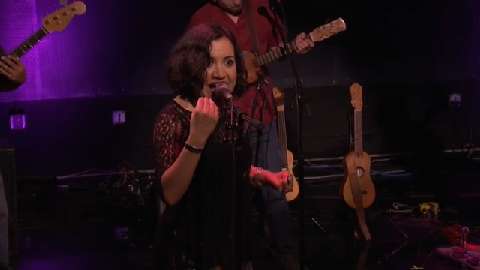
The Fiery Music of Quetzal
Watch the band's full performance on KCET-TV. Click here for future air dates.
Quetzal's career has been on a hot streak of late, especially after winning an unexpected Grammy award last year for Best Latin Album for their 2012 release, "Imaginaries." A string of gigs and other invitations to perform have followed since and the group is directing that momentum towards their sixth release in 16 years, "Quetzanimales." Only a few years ago, the band was on the brink of a permanent recording hiatus but now they're enjoying a second wind that's carrying them through 2014 and beyond.
Through their nearly 20 year history, the consistent core of Quetzal has always been the real-life partnership between guitarist Quetzal Flores and singer Martha Gonzalez. The two come from distinct musical backgrounds and it's not hard to trace the band's unique blend of American pop/rock/soul influences and folkloric Mexican styles back to their respective upbringings. Gonzalez grew up in Boyle Heights and was surrounded by aspiring musicians including her father, brother and uncle, all playing regional Mexican genres (rancheras, boleros, etc.). "It was such a family thing that by the time I became an adult, I remember thinking, 'I don't want to do this!' she said. Gonzalez went into theater and acting instead but she jokes that music was like the mob in "The Godfather," i.e. "pulling you back in!"
In contrast, Flores, who also grew up in various eastside neighborhoods, including the Emery Park tract of Alhambra where he and Gonzalez recently moved back to, came of age with an eclectic set of musical influences but unlike Gonzales, he says, "I didn't grow up with Mexican music. I grew up with R&B and soul and rock and roll; that was my thing." His mom kept Stevie Wonder, Franki Valli and WAR in heavy rotation in the house. His saw his cousin, Rocio Marron became an accomplished classical violinist. His uncle Joey introduced him to Jimi Hendrix while his older brother would come back from prep school on the east coast, bearing cassettes by The Smiths and Depeche Mode. It was his siblings who helped put Flores on the path to playing music: "my older brother started playing guitar. I wanted to be like my big brother, and then my sister dated this guy who was in a heavy metal band."
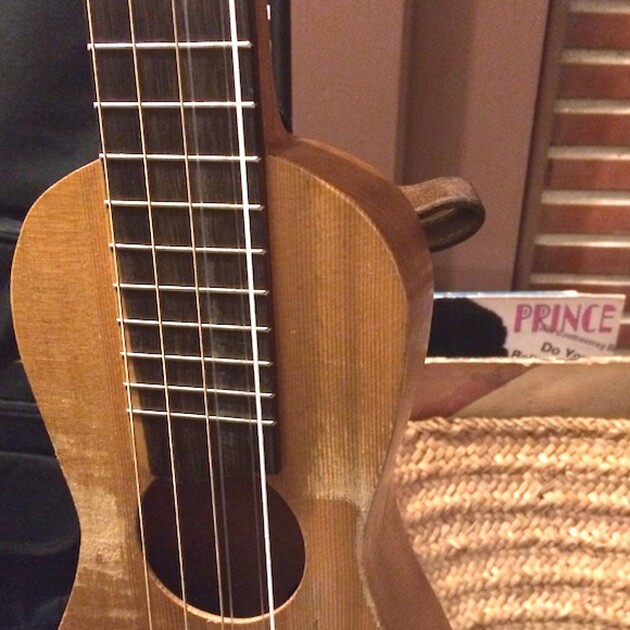
Around the same time Gonzalez was trying very hard not to follow in her family's footsteps, Flores was forming garage bands with local friends, influenced by new wave and modern rock. "They used to compare us to 10,000 Maniacs," Flores says about one of his early bands. Then two things happened that forever changed his and the band's musical identity.
First, Flores's musical mentor in the early 2000s, guitarist Marcos Loya, placed a jarana in his hand. This small guitar, central in son jarocho music from Veracruz, Mexico, had what Flores describes as a "magical quality." Not only was its timbre bright and evocative but Flores had mostly played electric guitar and now he was adjusting to the physical experience of cradling the jarana to his chest and playing without a pick. It was surprisingly profound for him, what he describes as, "this piece of wood that's resonating against your body. It was a whole different thing for me, opening me up to a whole different world that I wasn't accustomed to."
For someone raised on Johnny Marr but not mariachi, encountering the jarana and son jarocho were Flores's introduction to Mexican music. Coincidentally, it was around this same time that Quetzal hired a new singer who just happened to have been raised on those styles. "I was on a musical hiatus when I actually met Quetzal, a mutual friend of ours introduced us via pager," Gonzalez recalls. "He said, 'I have a friend that's looking for a singer." That's how it happened." In Quetzal, she found a band that wanted her for her voice and not just stage candy. In Gonzalez, Flores found someone who deeply felt at home with the kind of Mexican music he was beginning to build an affinity for. Along with input from his cousin Marron, bassist Dante Pascuzzo and other early members, Flores marks 2001 as "the real firm beginning of the identity of this band."
In order to understand that identity, one needs to appreciate how process is central to Quetzal: creatively, socially, politically, etc. It's telling, for example, that Flores's parents were both community/labor organizers and at the time the band formed, he was deeply inspired by the Zapatistas movement in Mexico. In those early years, the band took shape around this heady engagement with art, music, politics, radical ideologies and social movements. "We were just beginning to study these ideas of consensus and participatory democracy," says Flores, and they became an integral part of how band members tried to work with one another. They were trying to learn, "how you build a community or an organization to function in that way so that people...have accountability to this process, and that their voice needs to be in there," says Flores. Paraphrasing Cornell West, he adds that the band wanted to see itself as "not ornamental, but instrumental, essential to social movements."

That the son jarocho tradition is such a primary influence on Quetzal is no coincidence then. Though the style had long been commercialized within the Mexican record industry for decades, beginning in the 1970s, musicians began to reclaim the son jarocho, not just its songs but the broader community traditions around it, especially the fandango, an all-day/all-night fiesta that Gonazalez describes as a "musical, poetic, dance ritual." The fandango is not merely about playing son jarocho songs, it's about the social and interpersonal ties that are forged and strengthened through the events themselves. Quetzal members began traveling back and forth between L.A. and Veracruz, first participating in fandangos there and then gradually staging reaching out to likeminded friends and fans out here to stage their own.
As they began to slowly build a fandango tradition in Southern California, Quetzal also strove to record their music, releasing an impressive four albums over their first decade. However, after 2006's "Die Cowboy Die," they found themselves at a crossroads. They had made a name for themselves but they were still scrapping for every resource they could to keep touring and recording. Band members were getting restless for greater success, Flores and Gonzalez wanted more stability in order to start a family, and in the midst of this, Gonzalez received an offer she couldn't refuse: a scholarship to pursue a PhD in ethnomusicology at the University of Washington.
She and Flores relocated up to Seattle and between her studies, their distance from L.A. and the general challenges of a band trying to survive mid-career blues, Quetzal's recording momentum slowed to a halt. However, Flores notes, "we have physically left this community for extended periods, but we take the community with us. We take the ideals," and indeed, in Seattle, he and Gonzalez began to collaborate with local artists and musicians to develop a fandango network there as well.
Some might be surprised that the award was met with ambivalence; as Flores puts it, "there was no sense of validation" that came from it. As Gonzalez points out, "we've lived without [that kind of recognition] long enough, and made our careers without any kind of industry nod at all." That's not to say they didn't celebrate though. After the nomination had gone public, their friends and colleagues practically forced them to throw a fandango. On the Friday before the awards show, "people from Veracruz, people from the Bay Area, people from Tijuana, San Diego, Santa Ana, we all came together and we had a fandango that night," says Flores. "It was super-packed and that party went on until one in the morning, and the next day was the Grammys. So [the actual win] was all very anti-climactic, we had already celebrated."
That said, winning the Grammy didn't hurt their profile and it helped propel them towards recording the new "Quetzalanimales," what they describe as "their first concept album." That concept: 10 acoustic songs about urban animals. "With son jarocho, you write about animals," says Flores. "They become these themes by which people create poetry. They're usually metaphors for their own lives or some type of struggle." All band members contributed to crafting their own urban animal odes which includes songs about pigeons, owls and spiders.

In giving the group specific limits - only 10 songs, no "plugging in" musical equipment - they found the experience strangely freeing. Gonzalez proclaims, "honestly ,this has been the funnest album to write, for me." Sometimes, limitations allow one to focus rather than being paralyzed by trying to manage the infinite.
The Studio A performance included several songs from "Quetzalanimales" and what is striking is that even on the slower ballads, there is always the heavy pull of rhythm in their music. When Gonzalez isn't singing, she's stamping out a beat on a wooden box called a tarimas. This too goes back to the centrality of the son jarocho to Quetza's identity and sound; dance and rhythm are inextricably intertwined in the music and the fandango tradition. Gonzalez, who is now a Chicana/o Latina/o Studies professor at Scripps College, explains that Quetzal's use of rhythm is about continuing an ancient dialogue and adding their own message to that conversation: "I feel like rhythms, when people play them, they're not only meant to entertain the body, but I also think there's an element of ancestral lineage that is being communicated across time. There's a historical and political trajectory in rhythm, and that's how it was meant to be."





